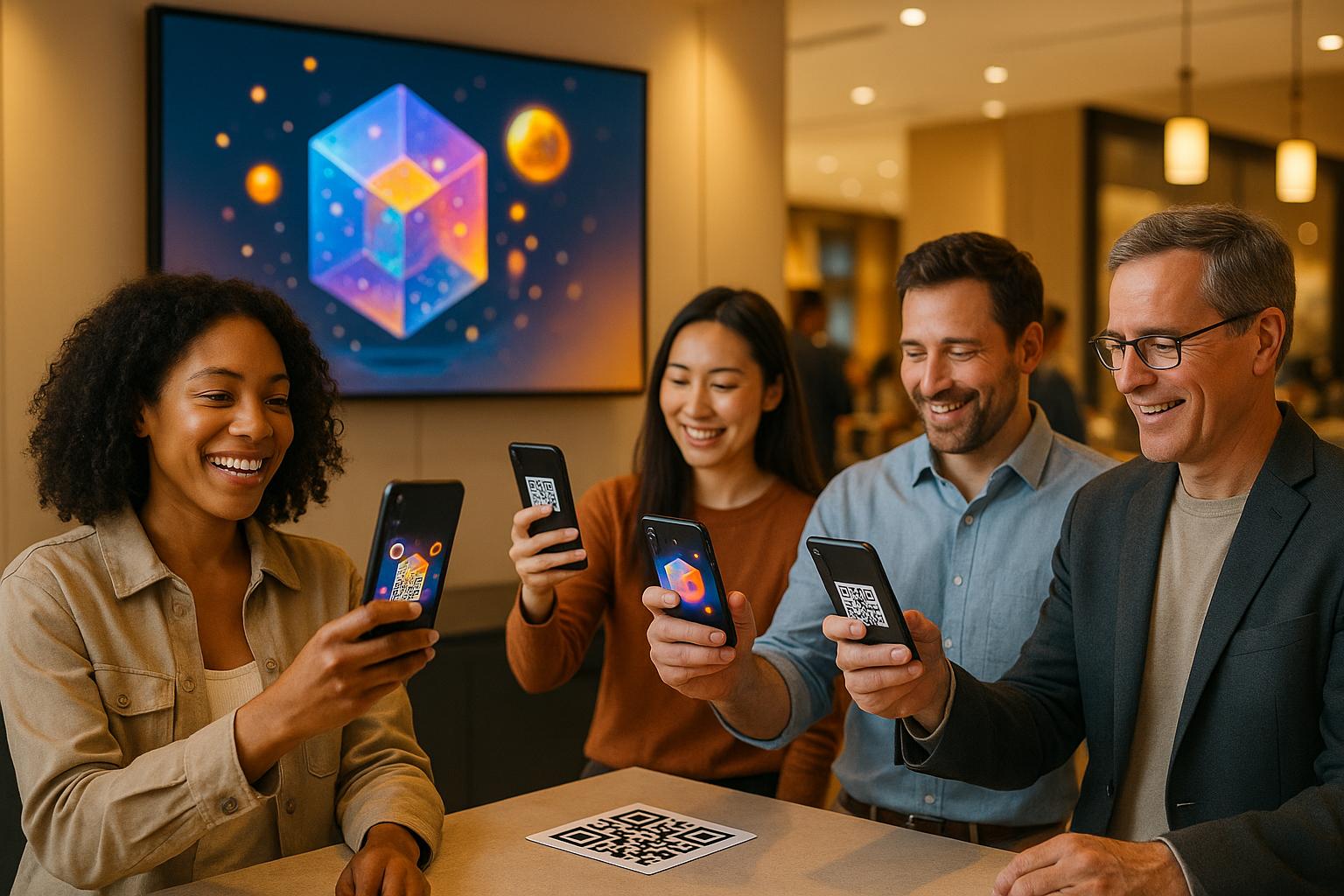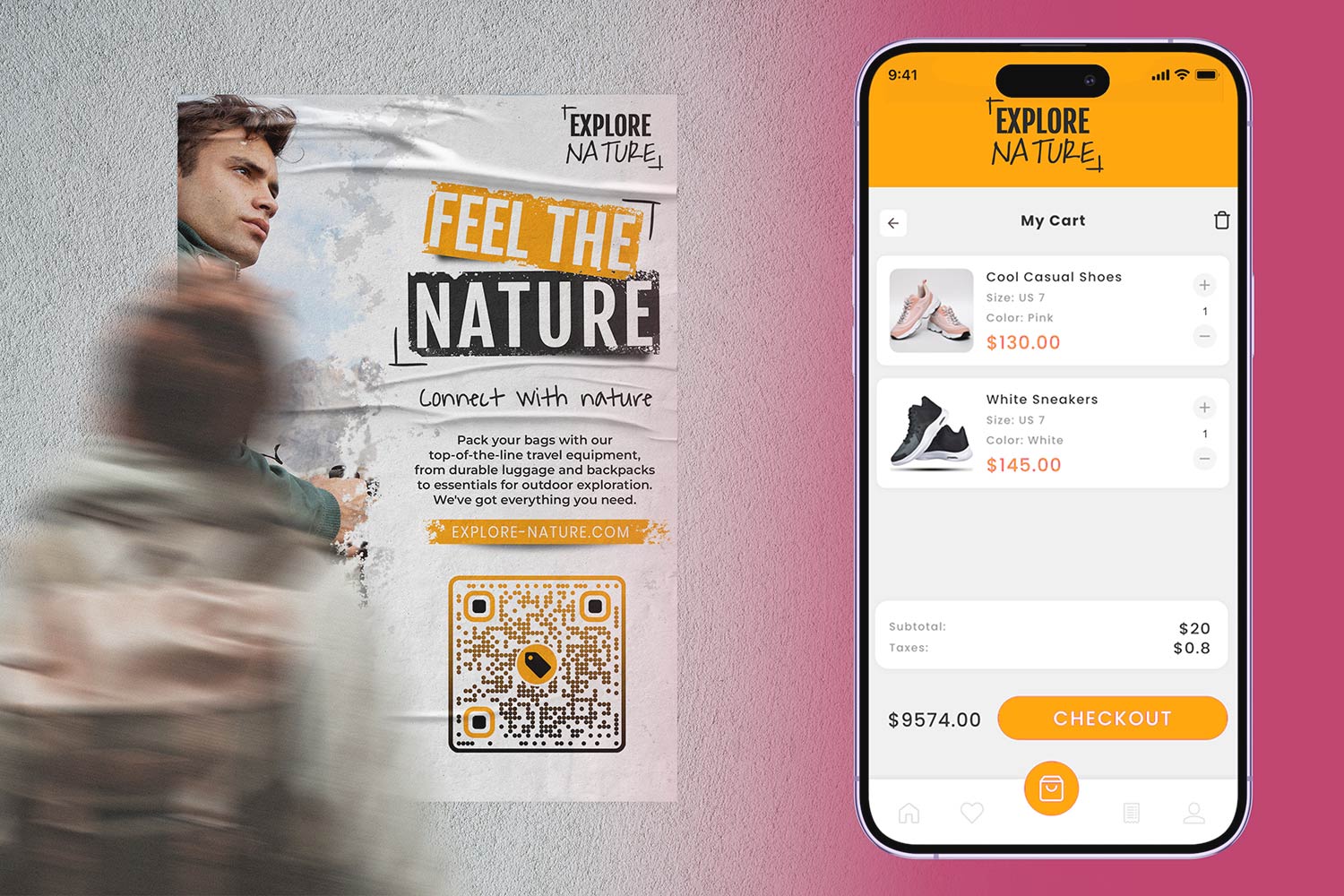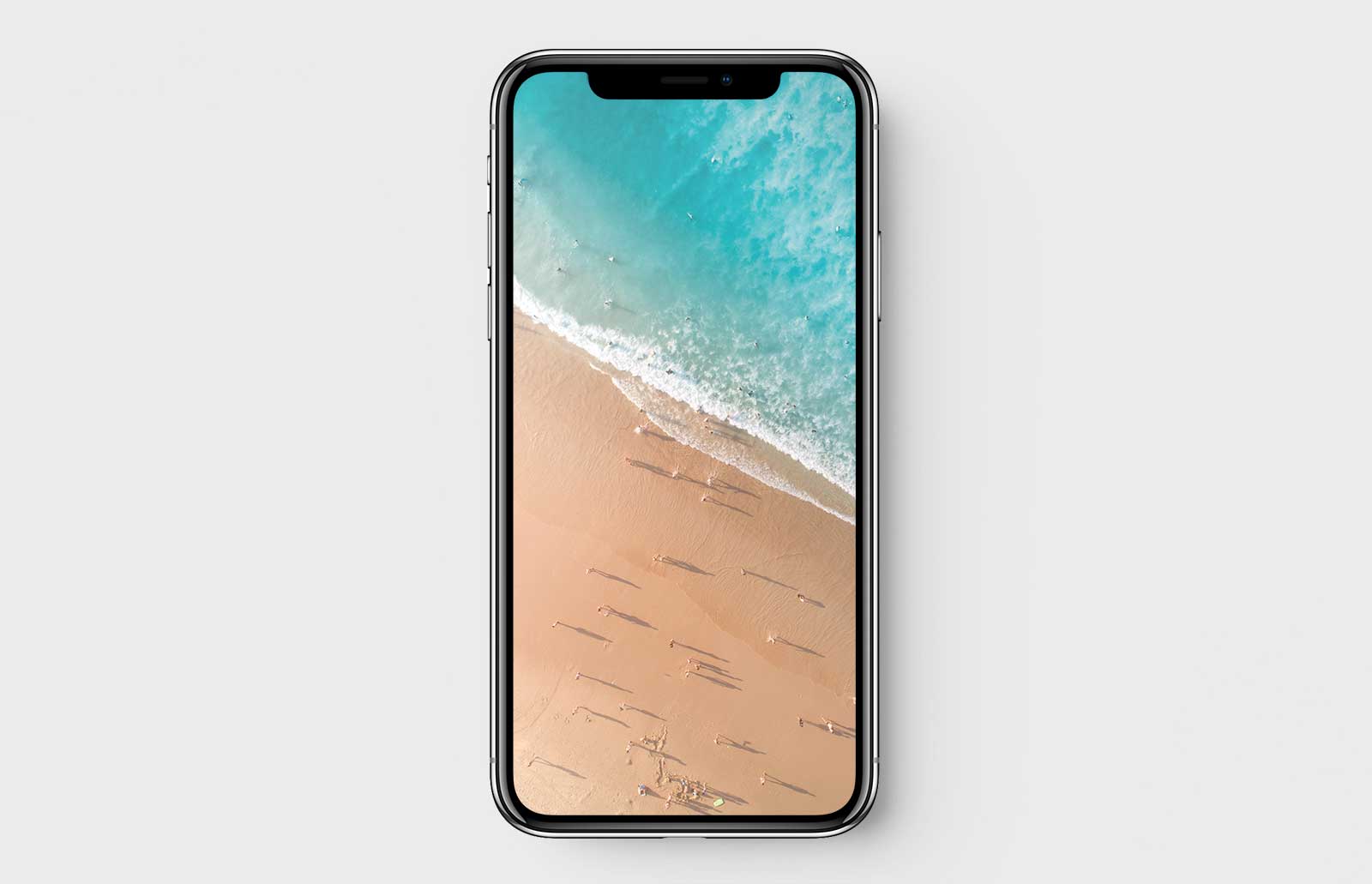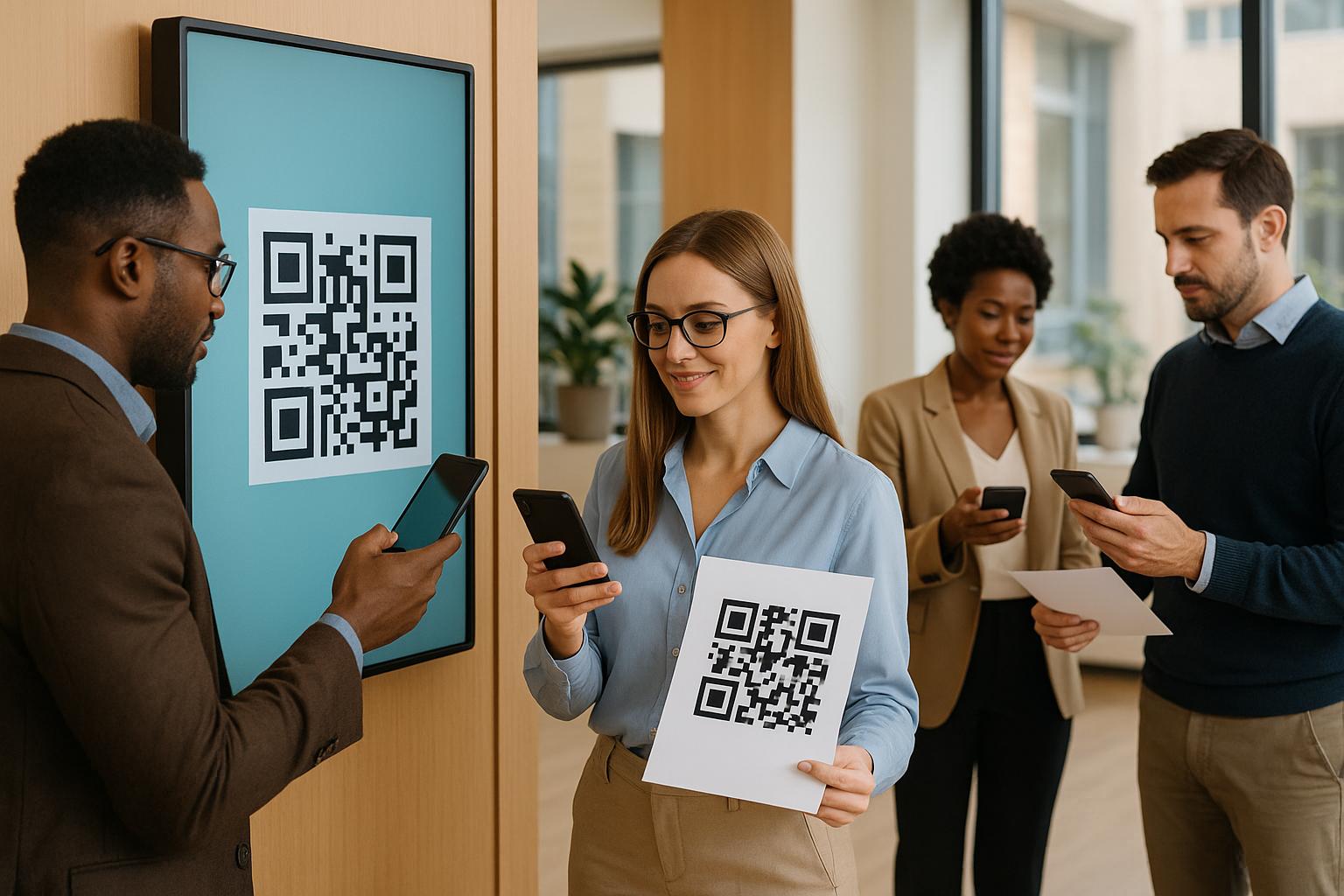AR QR codes are reshaping events by merging the physical and digital worlds, offering interactive and immersive experiences. Unlike standard QR codes, AR QR codes allow attendees to access 3D models, videos, and gamified content directly on their smartphones – no app required. Here’s what they bring to the table:
- Boost Engagement: AR experiences increase attendee interaction by 47% and loyalty by 22%.
- Streamline Operations: Simplify check-ins, crowd management, and real-time updates.
- Enhance Branding: Transform static materials into dynamic, shareable AR content.
- Advanced Analytics: Track performance and attendee behavior to improve future events.
- Real-World Examples: From AR scavenger hunts to holographic sports stats, events like Comic-Con and AT&T Stadium are leveraging this technology to create unforgettable moments.
Quick Comparison: Standard vs. AR QR Codes
| Feature | Standard QR Codes | AR QR Codes |
|---|---|---|
| Function | Links to static content | Offers interactive AR experiences |
| Engagement | Basic | Immersive and prolonged |
| Data Collection | Limited | Advanced interaction insights |
| Setup Complexity | Simple | Requires AR framework |
| User Experience | Informational | Engaging and dynamic |
AR QR codes are easy to implement and can elevate any event – whether it’s a conference, product launch, or festival. They’re not just tools for engagement but also powerful drivers of operational efficiency and brand impact.
Create AR Face Filters for Events, Festivals, and Concerts | ar-code.com

Key benefits of AR QR codes for event management
AR QR codes address three major challenges in event management: boosting attendee engagement, optimizing operations, and elevating brand experiences. They turn obstacles into opportunities for creating meaningful connections and executing events more smoothly.
Improving attendee engagement
AR QR codes transform events from passive experiences into interactive adventures. Instead of one-way communication, they create immersive moments that encourage active participation. This shift allows attendees to connect with the event in a more personal and engaging way.
A great example of this is Amazon Prime Video‘s collaboration with Rock Paper Reality during the 2023 Emmy Awards. They introduced a gamified AR experience where attendees could scan QR codes to explore physical sets, unlocking hidden details. This approach encouraged movement and exploration, with 70% of attendees participating. The result? Conversations sparked and connections formed between event-goers.
These interactive experiences also create shareable moments. Attendees often capture and post their experiences on social media, expanding the event’s reach organically. For instance, the Mikhail Chekhov Riga Russian Theatre celebrated the entertainer’s legacy by launching an AR scavenger hunt. Visitors scanned QR codes near special objects to access AR displays and explore Chekhov’s story across ten locations in Latvia. Anna Babre, PR Account Director at Ogilvy PR Latvia, explained:
"We realized that augmented reality would be the best way to safely and interactively unravel [Chekhov’s] story. People do not need an excursion guide. They can explore the track independently".
The ability to draw attendees into these unique, shareable experiences naturally complements the operational efficiencies AR QR codes bring.
Simplifying event operations
AR QR codes also streamline event logistics, handling tasks like check-ins, crowd management, and real-time updates. For example, a multinational company hosting a conference for 2,000 employees implemented a QR code check-in system. This reduced check-in times by 70%, ensuring the event started on schedule for the first time ever. At a large music festival with 50,000 attendees, QR codes managed entry, eliminated ticket fraud, and provided real-time crowd data.
By reducing the need for manual labor, AR QR codes minimize errors and cut costs. They also enable real-time monitoring, helping to track attendance and adjust for crowd imbalances. Using a QR code generator for event operations simplifies data collection and provides valuable insights for planning future events.
With smoother operations in place, event organizers can focus more on branding and promotion.
Improving event promotion and branding
AR QR codes breathe life into static materials, turning them into dynamic, interactive experiences. Flyers, posters, and tickets become gateways to 3D previews, virtual tours, or personalized AR content. This not only elevates campaigns but also collects valuable user data.
The branding potential extends far beyond the event itself. AR experiences often generate content that attendees share on social media, amplifying the event’s visibility. During London Fashion Week 2021, the Institute of Digital Fashion and Machine A created digital spaces for brands to showcase their stories using AR activations. These allowed remote participants to engage through custom AR filters. Stavros Karelis, founder of Machine-A, remarked:
"Digital fashion is not about trying to imitate the feeling of the IRL fashion world. It is about exploring a vast number of creative possibilities that are unique; encouraging new ways of engaging with the industry and how we can create a community that is much more inclusive".
AR content also leaves a lasting impression. Immersive experiences strengthen memory associations, leading to better brand recall and a higher ROI. For example, Comic-Con International used AR to showcase exclusive collectibles. Attendees could view animated 3D models of limited-edition items, complete with interactive 360-degree features. Additionally, at several business events, QR codes have improved networking efficiency by up to 70%, making it easier for attendees to connect and share information.
These examples show how AR QR codes are reshaping event experiences, making them more engaging, efficient, and memorable.
Step-by-step guide to implementing AR QR codes at events
Getting started with AR QR codes is easier than you might think. Here’s how you can use them to create memorable event experiences.
Choosing the right AR experience
The first step is to define your event’s objectives. What kind of experience do you want to offer attendees? Are you aiming to inform, entertain, or inspire specific actions? Your goals will guide every decision you make from here on out.
Equally important is understanding your audience. What are their interests and comfort levels with technology? The AR experience should feel natural and relevant to them, blending effortlessly into the event atmosphere.
"You need to define and align your goals and objectives for the event, and how they relate to your AR content and devices. You also need to consider the message and story you want to convey through your AR experience, and how they may resonate with your attendees always thinking about how to make the experience simple, informative and easy to activate." – Immersive Studio
Take inspiration from real-world examples. For instance, Amazon Prime Video’s gamified AR experience at the 2023 Emmy Awards saw 70% of attendees participating, sparking conversations and engagement throughout the event.
Some popular AR experiences include product demos, interactive scavenger hunts, virtual tours, and gamified challenges. The trick is to keep the experience easy to use, engaging, and aligned with your event’s theme.
Once you’ve nailed down your AR concept, it’s time to design QR codes that reflect your event’s branding.
Creating and customizing QR codes
After deciding on your AR experience, the next step is to design your QR codes to connect attendees with your content. The look of your QR codes plays a big role in encouraging people to scan them.
Customization matters. Incorporate your brand’s colors, logo, and clear calls to action to make your QR codes stand out. Platforms like Pageloot offer tools to create QR codes with custom logos, color palettes, and templates that align perfectly with your event branding. With over 25 QR code types available, you can ensure your AR content is delivered in the right format.
"The best thing about QR Codes is that you can make them colorful, eye-catchy, and prominent, unlike its successor, barcode." – QRCodeChimp Team
For events, dynamic QR codes are a game changer. They let you track scans and update content without having to reprint materials. This flexibility is especially useful for last-minute updates or reusing codes for different sessions. With Pageloot’s dynamic QR code generator, you can tweak your AR content even after distributing thousands of materials.
Before the event, test your QR codes on multiple devices to ensure they work seamlessly. Also, make sure the linked content is mobile-friendly and loads quickly – nothing turns people off faster than a slow or broken link.
Printing and displaying QR codes
Where and how you display your QR codes can make or break their effectiveness. Visibility and accessibility should be your top priorities.
Place QR codes on tickets, flyers, and posters at eye level where they’re easy to scan.
Digital displays are another great option. Use large screens, lobby monitors, or presentation slides to showcase QR codes in high-traffic areas. Adding animated elements or instructions like “Scan to explore exclusive AR content” can encourage more scans.
Make sure your QR codes are the right size for their placement. For printed materials, a minimum size of 1 inch x 1 inch works well, while larger displays can handle bigger codes that are easier to scan from a distance.
Finally, think about how the QR codes fit into your event’s overall design. Use frames, backgrounds, and enticing phrases like “Discover hidden features” to grab attention and drive action.
Once your QR codes are in place, it’s time to track their performance.
Tracking performance with analytics
Real-time analytics can turn your AR QR code campaign into a data-driven success. Pageloot’s analytics dashboard provides insights into scan rates, user engagement, and other key metrics, helping you adjust your strategy on the fly.
Track data like total scans, unique users, peak scanning times, and even geographic locations if applicable. This information can show you which placements are working best and when attendees are most engaged with your AR content.
For example, in 2023, Alabama’s largest hand-painted AR mural saw visitors spending an average of 118 seconds engaging with the content, and 67% of participants shared their experience on social media. The campaign’s earned media value outperformed its original investment by 4:1.
Use this data to make real-time adjustments. If certain QR code placements aren’t getting much attention, move them to more prominent locations or add signage to draw interest. If engagement dips at certain times, tweak your promotional efforts or adjust staffing accordingly.
The insights you gather don’t just help during the event – they also set the stage for improving future events and demonstrating ROI to stakeholders.
Advanced Use Cases and Customization Strategies
Once you’ve mastered the basics, it’s time to explore advanced strategies that can elevate your event experience. These approaches not only enhance engagement but also help you forge stronger connections with your attendees.
Popular Applications in Events
Contactless Check-Ins
Say goodbye to long lines at registration desks. With contactless check-ins, attendees can scan QR codes to access a personalized AR welcome experience instantly. This not only speeds up the process but also leaves a lasting impression, setting the tone for an exciting event.
Gamified Scavenger Hunts
Boost participation with interactive games. For instance, Nike used AR-powered tools like Nike Fit to help customers find their perfect shoe size, improving satisfaction and reducing returns. You can apply similar ideas by creating AR-based treasure hunts. Attendees could scan QR codes placed around the venue to unlock exclusive content, win prizes, or discover networking opportunities.
Interactive Sponsor Booths
Make sponsor booths stand out with AR features. Instead of static displays, sponsors can use QR codes to offer 3D product demos, virtual try-ons, or immersive brand experiences. With 67% of conference attendees expressing interest in more AR experiences, this approach can capture attention and provide value for both sponsors and guests.
Personalized Networking Experiences
Transform how attendees connect with each other. QR codes can enable AR business card exchanges, allowing participants to share contact details instantly in a fun, memorable way. This eliminates the need for physical cards while creating a dynamic networking environment. Considering that 79% of consumers want to use AR to interact with products before buying, these codes can also be leveraged for product launches and interactive demos during events.
These advanced applications build on earlier strategies, offering even more ways to engage and delight your audience.
Improving Visual Identity
Your QR codes should do more than just function – they should reflect your event’s brand. Pageloot’s tools make it easy to customize QR codes without compromising scannability.
- Color Coordination: Match your QR codes to your event’s color scheme while ensuring high contrast for easy scanning. Dark codes on light backgrounds work best, but you can experiment with your palette as long as the contrast remains clear.
- Logo Integration: Incorporate your event logo into the QR code design. A logo in the center adds professionalism and builds trust, encouraging more scans.
- Frames and Call-to-Action Elements: Add phrases like "Scan for Interactive Experience" or "Unlock Exclusive Content" around your QR codes. These small touches can guide attendee behavior and create excitement.
Don’t stop with the QR codes themselves. Think about where they’ll appear – on tickets, posters, or digital displays. Consistent branding across all these touchpoints reinforces your event’s identity and ensures a seamless AR experience. Always test your customized QR codes to confirm they work well across different devices and lighting conditions.
Using Detailed Analytics
Tracking QR code performance isn’t just a nice-to-have – it’s a game-changer. With tracked QR codes increasing engagement by 30%, analytics can provide valuable insights to optimize your event.
- Real-Time Monitoring: Adjust on the fly. If certain AR experiences are underperforming, you can make immediate changes to improve engagement.
- Post-Event Analysis: Dive into the data to see what worked and what didn’t. Identify which AR experiences drew the most attention, pinpoint peak scanning times, and uncover any bottlenecks in attendee flow.
Use scan data to identify high-interest audiences for future marketing, understand what content resonates most, and calculate ROI to justify your investment in AR QR codes. With 51% of businesses looking for better analytics in their QR platforms, this level of insight can set you apart as a forward-thinking event organizer.
sbb-itb-74874c9
Security, Privacy, and Marketing Automation
Event organizers face a balancing act: protecting attendee data while delivering personalized AR experiences. While AR QR codes can elevate events, they also introduce security challenges that require thoughtful planning and execution.
Ensuring Secure and Private QR Code Use
Protecting Attendee Data
When incorporating AR QR codes into events, safeguarding attendee information is a top priority. Regulations like GDPR classify biometric data – such as facial recognition or fingerprints – as sensitive, demanding strict handling protocols. If your AR experiences collect such data, robust security measures are non-negotiable.
Start by clearly outlining how attendee data will be used and implement an opt-in system. These steps build trust and establish a secure foundation for the technical measures you’ll put in place.
Technical Safeguards
Dynamic QR codes are a smart choice – they allow real-time updates to secure content without the need to reprint materials, reducing risks. Pairing these with HTTPS URLs ensures secure data exchanges. Additionally, QR codes are harder to counterfeit compared to traditional tickets, adding another layer of security.
Enhance security further by offering exclusive attendee-only content. This not only protects sensitive information but also adds an element of exclusivity to your event.
A Real-World Example
In 2023, Salesforce tested Wicket‘s Digital Pass system at select events, resulting in over 8,000 successful check-ins. Building on this, Dreamforce 2024 adopted Digital Pass as its primary check-in method, achieving over 30,000 opt-ins. With a 60% enrollment rate and 80% utilization, the system reduced check-in times by threefold compared to traditional methods, streamlining operations and boosting attendee satisfaction.
Privacy Compliance Made Simple
To stay compliant, collect only the data you truly need. If your AR experience doesn’t require details like location or extensive personal information, stick to basics like contact info.
"These concerns are indeed valid and have been witnessed in numerous instances of QR Code misuse. When you use a secure QR Code solution with robust regulatory policies and features, you can effectively address these concerns." – Ravi Pratap Maddimsetty, Co-Founder and Chief Technology Officer at Beaconstac HQ
Non-compliance with GDPR could lead to fines as high as €20 million or 4% of global annual revenue. Under CCPA, penalties range from $2,500 for unintentional violations to $7,500 for intentional ones. Platforms like Pageloot can help ensure your QR codes meet these regulations, protecting your event and your attendees.
By prioritizing security and privacy, you not only safeguard data but also strengthen your automated marketing efforts.
Integrating QR Codes with Marketing Automation
Beyond security, integrating QR codes with marketing automation can drive meaningful engagement and streamline workflows.
Linking Scans to Your Database
AR QR codes can seamlessly connect with your existing marketing automation systems. For instance, when an attendee scans a code, their action can automatically update your database – segmenting them based on interests or engagement levels. If someone scans a code at a sponsor booth for an AR product demo, they can automatically be tagged as a qualified lead in your CRM. This eliminates manual data entry and ensures no potential connection is overlooked.
Automated Follow-Ups and Notifications
QR code interactions can trigger automated email sequences, keeping attendees engaged. For example, someone who scans a code for an AR networking experience might receive a follow-up email with contact details of people they met, along with additional resources. Your marketing automation system can also send real-time notifications to your team when high-value prospects engage, enabling timely follow-ups while interest is still fresh.
"QR Codes have become essential for both marketing and non-marketing purposes, benefiting both users and businesses alike… They are not just a way of sharing information but also a form of collecting valuable data and insights about consumer behavior, preferences, and engagement." – Ravi Pratap Maddimsetty, Co-Founder and Chief Technology Officer at Beaconstac HQ
Tracking Behavior and Audience Segmentation
QR code scans provide valuable insights into attendee preferences. By monitoring which AR experiences generate the most engagement, you can identify behavioral patterns and segment your audience accordingly. This information is invaluable for tailoring future events and marketing strategies. You can even create QR codes that direct different audience segments to personalized AR experiences, making interactions more relevant and impactful.
Seamless Integration with Existing Tools
Most marketing automation platforms support integration with QR code analytics through APIs or webhooks. This allows scan data to flow directly into your workflows without the hassle of manual transfers or separate systems. Choose a QR code platform that integrates smoothly with your CRM, email marketing tools, and analytics platforms to ensure a seamless flow of data – from scan to conversion.
Comparing Standard vs. AR QR Code Event Experiences
Expanding on the earlier discussion of AR QR codes, comparing them with standard QR codes reveals just how much they can elevate event experiences. While traditional QR codes simply link users to static content, AR QR codes take it a step further by blending digital elements into the physical world.
A Shift in Functionality
Standard QR codes are straightforward – they redirect users to static pages like event details or registration forms. In contrast, AR QR codes create immersive experiences by overlaying interactive digital content onto the real world. Imagine scanning an AR code at a sponsor booth and seeing a 3D product demo appear right in front of you. This approach keeps attendees engaged in both the physical and digital spaces, enhancing their overall experience and interaction.
Engagement Levels Speak Volumes
Standard QR codes are practical for quick information access, but AR QR codes captivate users with interactive and immersive content. This aligns with consumer preferences: 79% of people express interest in using AR to explore products before purchasing. Moreover, Gartner predicts the AR/VR industry will reach $370 billion by 2034, underscoring the growing demand for such experiences.
Expanding Data Collection
When it comes to data, the difference is striking. Standard QR codes offer basic tracking, such as scan counts, location, and carrier data. AR QR codes, however, provide advanced data collection capabilities, including device-specific details and interaction patterns. Platforms like Pageloot’s QR code generator enable event organizers to gain deeper insights into attendee behavior, paving the way for targeted follow-ups and more effective event strategies.
Comparison Table of Features
| Feature | Standard QR Code | AR QR Code |
|---|---|---|
| Primary Function | Redirect to static webpage or resource | Overlay digital content onto real-world environments |
| Interactivity | Limited to static redirection | Interactive 3D models, videos, and animations |
| User Experience | Quick access to information | Immersive and tailored experiences |
| Visual Appeal | Basic black-and-white pattern | AR markers with enhanced visual triggers |
| Engagement | Short interaction | Prolonged, immersive engagement |
| Data Collection | Basic tracking (scans, location) | Detailed interaction and device data |
| Setup Complexity | Simple generation | Requires AR framework and marker setup |
| Content Updates | Static content (or dynamic with upgrades) | Real-time, interactive updates |
| Marketing Impact | Functional information delivery | Memorable, engaging experiences |
| Audience Retention | Users leave physical space to view content | Users stay engaged in the physical environment |
Choosing the Right Fit for Your Event
Deciding between standard and AR QR codes depends on your event goals and audience expectations. Standard QR codes are ideal for straightforward tasks like sharing event ticket details or enabling quick registrations. On the other hand, AR QR codes shine when creating standout experiences, making them perfect for product launches, sponsor activations, and interactive exhibits.
Consider your audience’s comfort with technology and the nature of your event. With mobile QR code scanner usage in the U.S. expected to surpass 100 million users by 2025, both options hold promise. However, AR QR codes offer a level of engagement and immersion that can make your event truly unforgettable.
Conclusion
AR QR codes are changing the way we experience events by blending the physical and digital worlds in a way that’s both engaging and practical. These codes elevate ordinary interactions into unforgettable moments that attendees can actively participate in.
For event organizers, they simplify operations and provide tools like real-time analytics from platforms such as Pageloot, enabling smarter, data-driven decisions for future events. Meanwhile, attendees benefit from features like interactive 3D previews and gamified activities, creating a more dynamic and enjoyable experience.
What makes AR QR codes even more appealing is their accessibility. There’s no need for specialized apps or AR headsets – just a smartphone scan unlocks the interactive possibilities.
With Pageloot’s user-friendly platform, creating a QR code tailored to your event is straightforward. You can incorporate custom branding, manage dynamic content, and access real-time analytics effortlessly. Whether it’s a trade show, a conference, or a product launch, AR QR codes can help you craft experiences that leave a lasting impression.
FAQs
What makes AR QR codes more engaging and effective than standard QR codes?
AR QR codes bring a new dimension to user engagement by delivering interactive augmented reality experiences. Unlike traditional QR codes that only share static information, these codes immerse users in visually rich and dynamic content, creating experiences that leave a lasting impression. This makes them perfect for elevating events and marketing campaigns.
What sets AR QR codes apart is their ability to provide detailed data insights. By tracking how users interact with the augmented reality features, marketers can gather valuable information about audience behavior and preferences. This data helps fine-tune strategies and craft more tailored, impactful campaigns. With their unique capabilities, AR QR codes are transforming how brands connect with their audiences.
How have events successfully used AR QR codes to improve attendee experiences?
Events like concerts, festivals, and art exhibitions have embraced AR QR codes to elevate the experience for attendees. With a quick scan, participants can access interactive content like AR filters, exclusive videos, or behind-the-scenes footage. These features add an extra layer of fun and make the event stand out in people’s memories.
On a larger scale, AR QR codes have been used for quick check-ins, interactive games, and tailored campaigns. These applications simplify event logistics while keeping attendees engaged, ensuring the event leaves a strong and lasting impact.
How can event organizers protect attendee data when using AR QR codes?
To keep attendee data safe, event organizers should implement dynamic or encrypted QR codes. These codes make it harder for anyone to gain access without permission. It’s also important to collect only the data you absolutely need and to provide attendees with clear privacy notices, ensuring compliance with regulations like GDPR or CCPA.
For added security, use reliable scanning tools and activate authentication features during check-ins and other interactions. By focusing on transparency and robust security measures, you can build trust and confidence with your attendees.

























